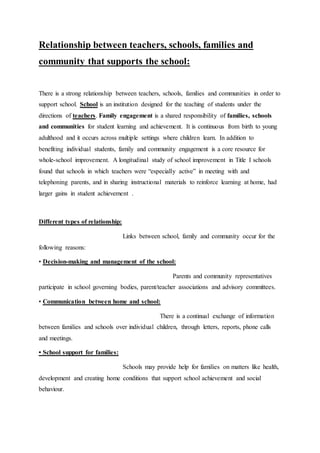
SchoolSuccessThroughFamilyCommunityConnections
- 1. Relationship between teachers, schools, families and community that supports the school: There is a strong relationship between teachers, schools, families and communities in order to support school. School is an institution designed for the teaching of students under the directions of teachers. Family engagement is a shared responsibility of families, schools and communities for student learning and achievement. It is continuous from birth to young adulthood and it occurs across multiple settings where children learn. In addition to benefiting individual students, family and community engagement is a core resource for whole-school improvement. A longitudinal study of school improvement in Title I schools found that schools in which teachers were “especially active” in meeting with and telephoning parents, and in sharing instructional materials to reinforce learning at home, had larger gains in student achievement . Different types of relationship: Links between school, family and community occur for the following reasons: • Decision-making and management of the school: Parents and community representatives participate in school governing bodies, parent/teacher associations and advisory committees. • Communication between home and school: There is a continual exchange of information between families and schools over individual children, through letters, reports, phone calls and meetings. • School support for families: Schools may provide help for families on matters like health, development and creating home conditions that support school achievement and social behaviour.
- 2. • Family and community help for schools: Parents, community and employee volunteers may assist children, teachers or school management in the classroom or in other aspects of school activities. • School support for learning at home: Schools may help families to develop learning at home to help in turn the child’s learning at school. • Collaborations with community agencies: Outside agencies, both local and national, provide the school with access to community and support services for children and families. • Community education: Learning opportunities may be available for all age-groups, both within and outside the school and within and outside the conventional school hours. Differing needs: The kinds of relationship change as children grow. In pre- and primary school, support for the child is directed through the family. In secondary school there is gradual need to view the child as an individual with needs for information, help and experiences which reinforce autonomy and independence. The period of middle childhood is not well served by support programmes. There is little evidence of thinking about the changing support needs of children in transition to adulthood and from primary to secondary school. Community schools relationship: Which offer community education to local people and facilities outside school hours, are well-placed to develop relationships with other agencies. There is some evidence that this approach has improved failing schools, and that the experience of learning alongside adults can improve motivation and behaviour in young people. Community education supports young people by: • making the school a more convivial place.
- 3. • presenting learning as desirable at all ages. • giving opportunities for social interaction. • enabling parents to participate in meeting their own needs. • offering learning situations to meet individual need. • raising the reputation of the school in the local community. The RelationshipbetweenFamily Involvement and Student Success: There is a positive and convincing relationship of School,Family,andCommunityConnectionson StudentAchievement. 1. Involvement programs that link to learning improve student achievement: It’s simple: The more parent and community involvement activities focus on improving student learning, the more student learning improves. Learning-focused involvement activities may include ● Family nights on math or literacy. ● Family-teacher conferences that involve students. ● Family workshops on planning for college. 2. Speaking up for children protects and promotes their success. Children whose parents are advocates for them at school are more confident at school and take on and achieve more. The more families advocate for their children and support their children’s progress, the longer their children stay in school and the better their children do. Families should: ● Become knowledgeable about the operations of schools and the laws that govern those operations. ● Be confident about their ability to work with schools. ● Expect only the best from their children and for their children. ● Join PTA. 3. All families can contribute to their children’s success. Family involvement improves student success, regardless of race/ethnicity, class, or parents’ level of
- 4. education. For involvement to happen, however, principals, teachers, and parents themselves must believe that all parents can contribute to their children’s success in school. Parents can promote their children’s academic success by: ● Teaching their children the importance of education. ● Finding out what their children are expected to know and to be able to do and reinforcing lessons at home. ● Sending their children to school ready to learn every day. Principals and teachers must support parent involvement by: ● Making parent involvement a priority. ● Recognizing and removing barriers to parent involvement. ● Sharing decision-making power with parents and community members. ● Working to understand class and cultural differences. 4. Community organizing gets results: Engaging community members, businesses, and organizations as partners in children’s education can improve the learning community in many ways. For example, community partners may be able to: ● Provide expanded learning opportunities. ● Build broad-based support for increased school funding. ● Provide quality after-school programs. Our schools are not working very well for any students, so that the entire system Needs fundamental changes if we are to prepare youngsters to be productive citizens And workers for the next century. This perspective calls for fundamental shifts in our Conceptions of the classroom, of the school, of governance and authority Relationships, and of organizational structures supporting schooling. In turn, these changes require a new series of relationships between the classroom and home, between educators and families, and between schools and their broader community. Government should take steps to make this relationship stronger in order to support the schools more efficiently so, that students can learn more effectively ______________________________
